Have you ever heard the expression “higher on the food chain”? Alternatively, another common and related expression is the “web of life” or “circle of life”. All of these terms sound cool and important, but what do they mean? More importantly, what can they tell us about how nature works? Ask any scientist or naturalist, and they’ll tell you that the term you’re after is food webs. But what is a food web? In this Deep Stuff post, let’s learn about food webs and why the matter.
All about connections

The cliché expressions I mentioned above all have one thing in common: connection. Chains, circles, and webs are all about pieces that fit together, links that connect with one another. This is precisely the take-home point of food webs.
Food webs are one of the most fundamental concepts in ecology. To break things down, ecology is the study of how living things interact with each other and their environment. Food webs are a way of describing one major way in which living things interact. Specifically, who eats whom.

A helpful metaphor
A food web is an imaginary representation of the interactions between different living things that eat one another. These connections are also known as trophic links, a term that comes from the Greek trophē “nourishment”. Each trophic link defines how one organism gets nourishment by feeding upon another one.
In other words, trophic webs show how energy is passed from one living thing to another in an ecosystem. For example, if you eat a hamburger or a steak, there is a trophic link between you and the cattle on a farm somewhere. Furthermore, there is a trophic link between that cow and the living plants that it ate during its lifetime.
The cow eats the grass, and you ate part of the cow. That makes two links in a food chain. In a food chain, each organism is connecting to 2 or fewer other living things. That makes it linear, shaped line a stretched-out chain. In order to make a food web, we need more living things involved, and more interactions between them.
Weaving a web
A set of trophic links starts to become a trophic web when you consider more than two species that share more links. Scientists and naturalists often construct food webs for individual habitats or ecosystems.
One helpful place to start thinking about food webs is in our own back yards or gardens. Especially if you take steps to Garden for Wildlife, your back yard supports its own small ecosystem. Public parks will be much the same. Looking around a typical park, garden, or back yard, we might see living things like:
- Grubs and worms in the dirt
- Grass
- Carabid beetles running around flower beds
- Robins (in the Americas) or Blackbirds (in Europe)
- Oak, maple, or cherry trees
- Chipmunks or squirrels
- Opossums or raccoons
- Soaring hawks
A food web at home and at the park
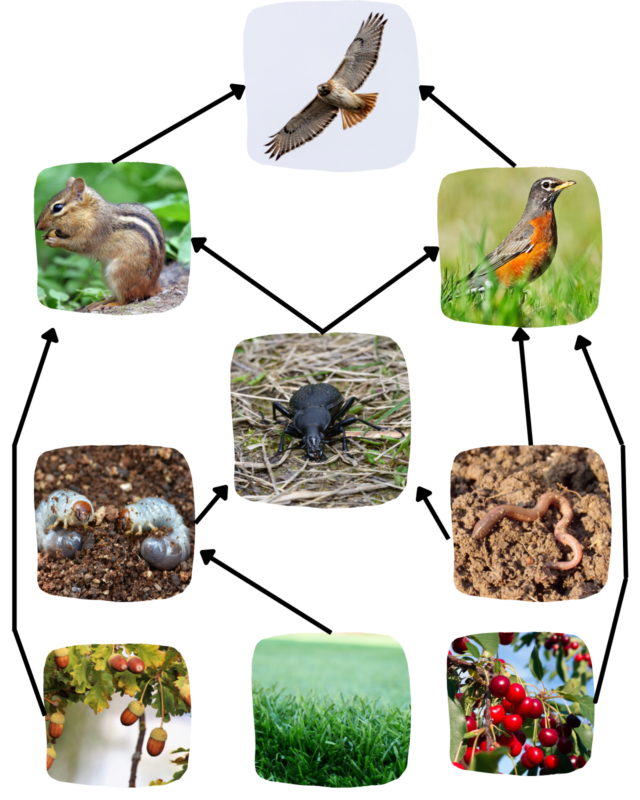
Starting at the “bottom”
The interactions between these common backyard plants and animals make up their trophic connections. When one species feeds on another, it acquires some of its energy. Energy flows up the food web (or food chain) from prey (organisms that get eaten) to predators or consumers (those that do the eating).
For instance, carabid or ground beetles (family Carabidae) eat earthworms as well as pest insects and grubs in the soil. Similarly, thrushes like robins and blackbirds (Turdus sp.) feed similarly on invertebrates in the ground, including not only a diversity of harmful pests but also carabid beetles.
The vertebrates
Birds like thrushes also feed heavily on spiders, which themselves control flying insects. Meanwhile, pest insects and their larvae that don’t get eaten are feeding upon the roots of grass or on the leaves of trees. The surrounding trees may provide fruits and nuts that feed chipmunks, squirrels, opossums, racoons, and thrushes. In turn, soaring hawks (Buteo sp.) eat many small mammals as adults or as young.
As you can probably imagine, there are a lot more living things in any garden or park than the eight groups that I listed above. Furthermore, these various plants, animals, fungi, and other forms of wildlife interact in a lot of different ways. The example above is thus a very simplified one, but it can help us observe some key characteristics of field webs.
For instance, you may notice that the food web shows different levels. There are plants at the bottom of the food web, then some things that eat the plants. There are things that eat the plants, and things in turn that eat them. These stages of the food web are called trophic levels.
What are trophic levels?

Trophic levels are a label that scientists and naturalists use to describe the role that an organism plays in a food web. You can break food webs down into some basic categories of trophic levels:
- Producers (the lowest level)
- Consumers (higher levels)
- Decomposers (the levels that “close the loop”)
As you go up the food web, you encounter “higher” trophic levels. At each of these stages, the energy from more and more organisms is being transferred up to that level.
Producers
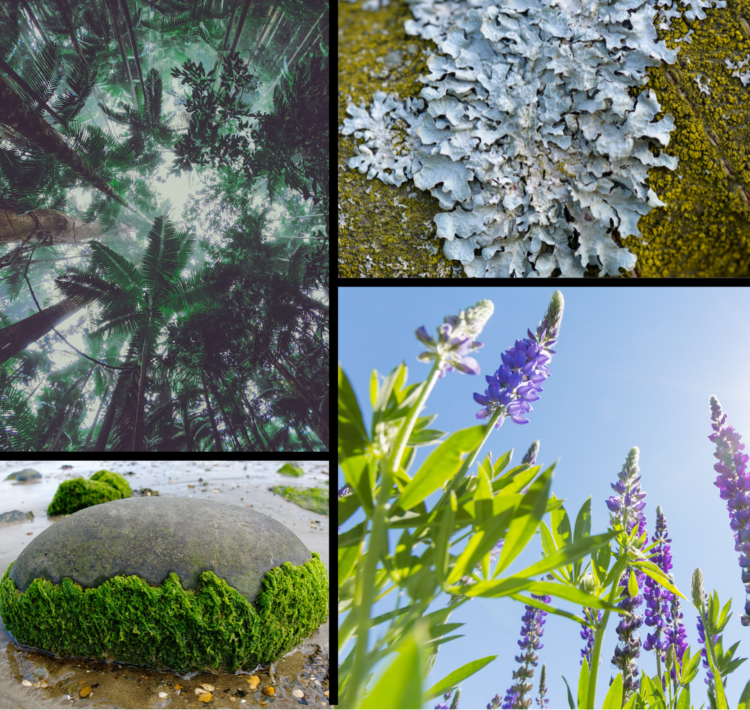
Producers are living things that can harvest energy from non-biological sources and convert that into organic molecules. Scientists call them autotrophs, self-nourishing. Nearly all producers on the planet are phototrophs, light-nourishing. In other words, they harness light energy from the sun to produce chemical energy. This, in turn, provides the vast amounts of organic chemical compounds that not only fuel the producers, but also most of all other life on Earth. They are often green, which is the dominant color of the pigments they use for capturing light. Green phototrophic producers include:
- Green algae
- Cyanobacteria
- Most species of plants
- Lichens
A small number of other organisms called chemoautotrophs or chemical-self-nourishers derive their own energy by breaking down inorganic compounds. More on them in a future post.
Consumers
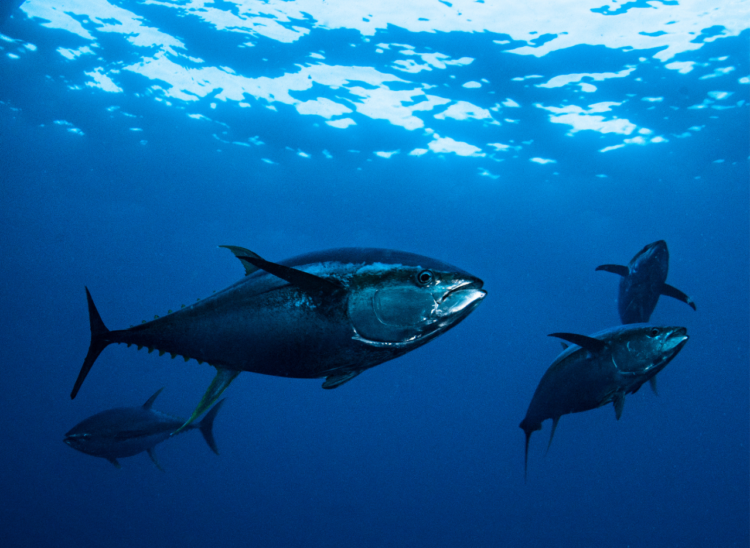
Ecologists call living things that eat other living things consumers. This includes the grubs that eat your lawn, and the ground beetles that eat those grubs. It also includes you and I. This is because, whether we’re vegan or vegetarian or omnivorous, we have to eat other organisms for energy. Consumers are incapable of producing their own energy, and must derive it from materials produced from other organisms. Scientists call these heterotrophs, meaning “other-nourishing”. Simply put, consumers eat other living things to get the energy and nutrients they need to live.
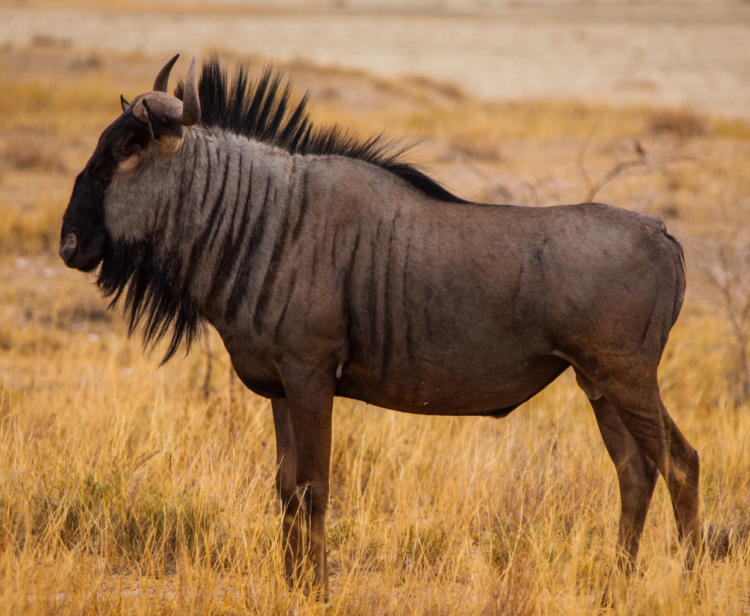
The first round of consumers that feed directly on producers are primary consumers. The ones that eat them are secondary consumers, followed by tertiary consumers, and so on. You’ll notice from the suburban park example that some animals can be both primary and secondary consumers. You can, too! When we eat plant matter, we’re being primary consumers, absorbing energy that was fixed by producers. When we eat animal or fungal matter, we’re taking in energy that was harvested from producers by another organism.
The highest-level consumers in every habitat are apex predators. These are often large animals that eat other consumers and don’t have natural predators as adults. Their energy is typically only passed on to decomposers after they reached adulthood.
Decomposers
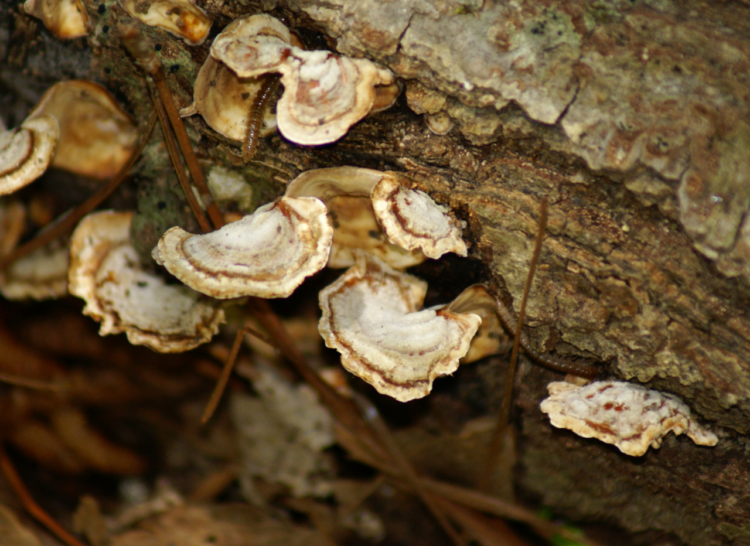
Decomposers are heterotrophs that derive their nutrition and energy from non-living matter. That is, they eat dead stuff. That stuff can be anything that was formerly alive. Many people refer to decomposers as “nature’s cleanup crew”. Decomposers are the ones that complete the “circle of life”. Decomposers break down dead organisms into nutrients that producers can consume. In other words, they recycle nutrients from all levels of the food web back down to the bottom.
To give a more accurate picture of the role of decomposers in our backyard trophic web, I would need to put some extra arrows going from every other animal to the earthworms. In this example, the earthworms and some other invertebrates would be the ones breaking down a dead robin or hawk into organic matter in the soil.
Scavengers and microscopic workhorses
Decomposers break down any kind of formerly living matter, including animals and plants. For example, a variety of mushrooms (fungi), microbes, and invertebrates eat dead or decaying plant matter. Of course, plants aren’t the only things that die and leave their remains behind. All animals die, too, and there are lots of decomposers out there that can clean them up. Scavengers are animals that seek out other dead animals and eat them, converting their dead matter into energy and living tissue in their own bodies. For instance, vultures will find carcasses over large areas by smell and help break them down by feeding.
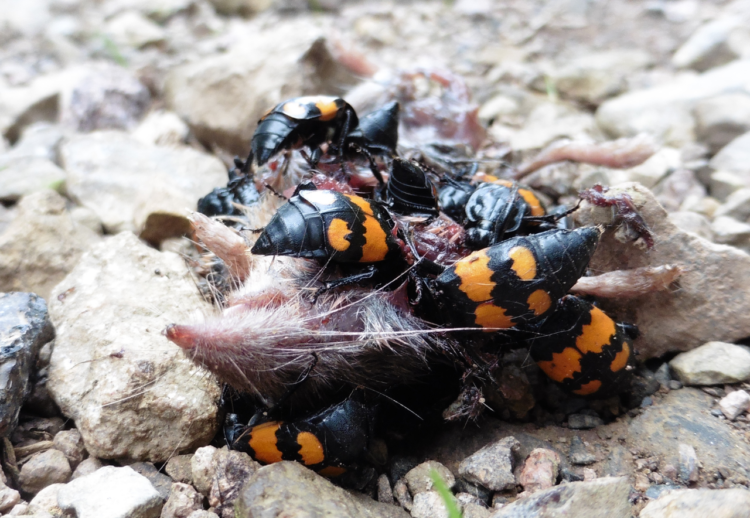
On the other hand, fungi, microbes, and invertebrates really take the cake as the predominant decomposers of the natural world. Without them, dead things would pile up to a totally unmanageable level in very little time at all. Although most small decomposers, like bacteria and molds, are so small you can’t really see them, there are some that you can easily watch in action. One example is the burying beetle (Nicrophorus sp.), which bury dead animals underground as a food source for their young.
Thanks for reading what is a food web!
Have you witnessed the flow of energy from one organism to another in nature? Share your experience in the comments! As always, you can get in touch using the Contact form if you have questions about this or other posts.
